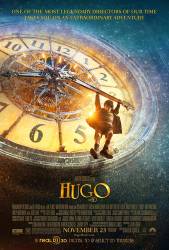Continuity mistake: When the monkey-wrench falls, it lays on the middle of two tiles. When the angle changes, it lays on the center of a tile.
Continuity mistake: When the automaton signs the drawing, it makes a dot inches away to the right of the "L". When Hugo hands the drawing to the lady, the dot is a thick mark right over the "L".
Continuity mistake: After the inspector saves Hugo, he yells at him "What were you thinking of?" Hugo's hair is moving wildly in one angle, still in the next angle, then wild, and finally back to still.
Continuity mistake: While the inspector flirts with Lissette, she is standing sideways or straight, depending on the angle.
Continuity mistake: When Hugo bumps into Labisse and the books fall, their position changes between shots.
Continuity mistake: When the drawings fly all over the room, the ones on the box's lid appear / disappear randomly between shots.
Continuity mistake: When the automaton signs the drawing, the tip of the "G" is under a line circling the moon's face. When the angle changes, the "G" is covering part of the moon's face.
Continuity mistake: When Isabelle chases Hugo at the station and falls on the floor, her position is inconsistent between shots.
Continuity mistake: After the automaton stops writing for the first time, Hugo steps backwards and faces it with his head positioned straight. A frame later it's tilted to the left.
Continuity mistake: When Isabelle hands the key to Hugo, the length of the string attached to it decreases between the first and second shot.
Continuity mistake: Lighting on the automaton changes between shots when Hugo uncovers it for the first time, notice the structure underneath: from hidden to visible.
Continuity mistake: Hugo tucks the beret covering his eyebrows, but a frame later it's above them.
Continuity mistake: When Uncle Claude shows up to deliver the bad news, Hugo turns around twice.
Continuity mistake: When Frick greets the lady for the first time, a waiter suddenly appears next to her in the second angle.
Continuity mistake: When Hugo leaves the notebook on the counter, it swaps from laying straight to skewed between shots.
Continuity mistake: At the toy-shop, Hugo empties his pocket and Méliès places his hand over the cloth and then takes it back. From the opposite angle, the hand is still over the cloth.
Continuity mistake: When Méliès shows up during the projection, Tabar turns around twice.
Continuity mistake: When Hugo is walking with his uncle, carrying the automaton, the way he holds it differs between the first and second shot.
Continuity mistake: The position of the automaton's arm when writing for the first time is inconsistent between shots.
Continuity mistake: When Hugo is outside Isabelle's place for the first time, he is standing by the middle of a brick column. When the angle changes he is by its side.





